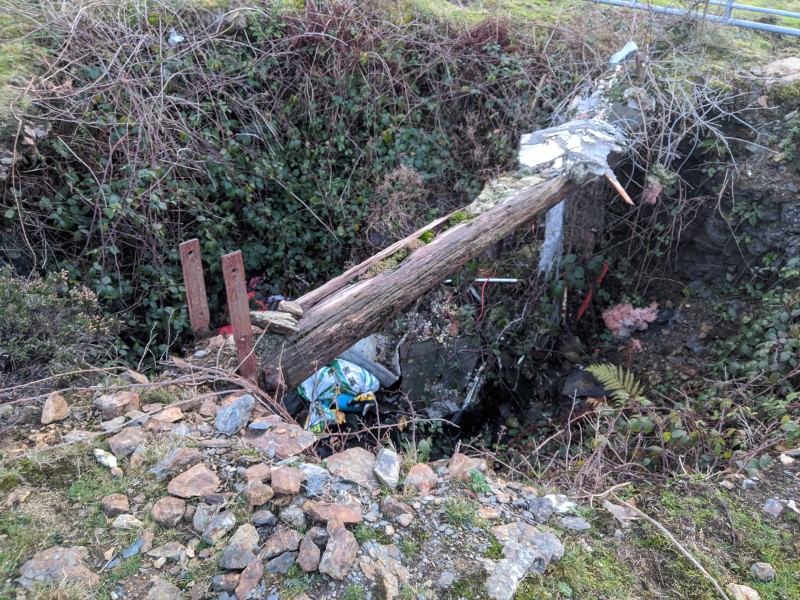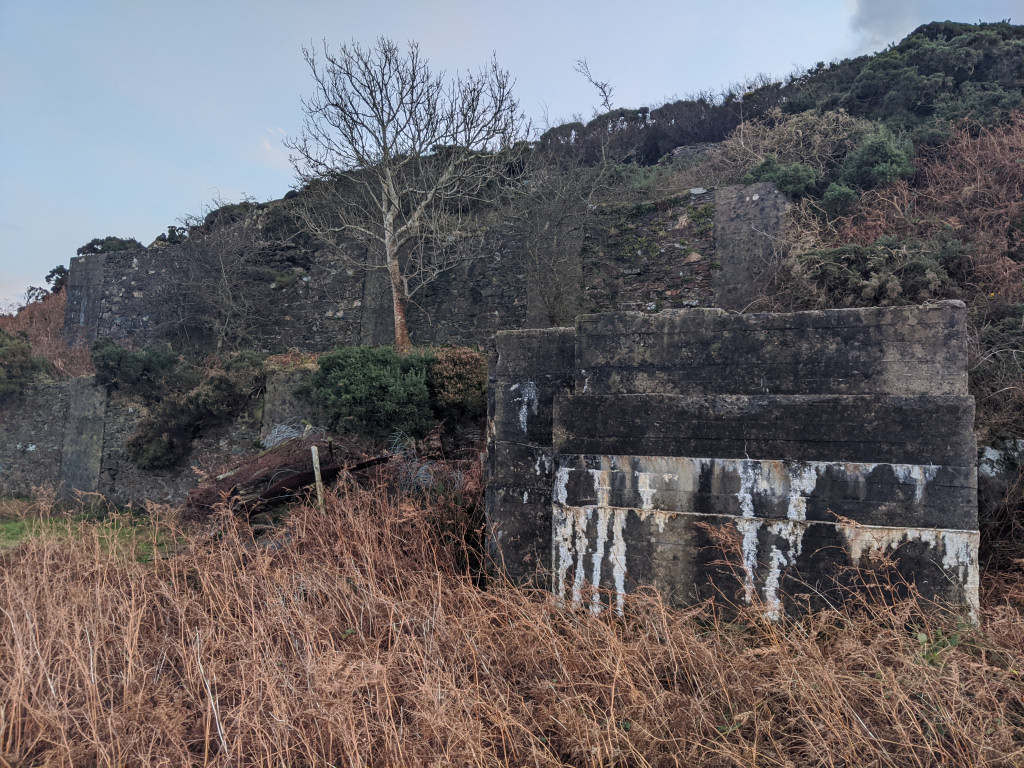Other minerals found in the area include iron, bismuth, silver, and gold. There are three shafts, each around 200 feet deep, along with an adit at sea level. Numerous old levels exist above the adit, and a level has been driven from the engine shaft toward the South Lode, with a crosscut extending to the North Lode. Additionally, there are four sinkings below the adit level, measuring 101, 70, 66, and 28 feet deep.
On the ground, the most prominent remains are some concrete abutments and a large square shaft surrounded by fence and filled with rubbish - see photo.
Greenly:
“About 30 years ago, [1822] shafts and levels were driven into the rocks of the small Silurian infold and chalcopyrite was obtained, but the mine was eventually deserted. It has lately [1912?] been reopened, and the usual pyrite and chalcopyrite (unaccompanied, apparently, by bluestone) again obtained. At one spot (and there only in quite small quantities) an interesting ore was met with, which yielded an average of 0.5 oz., a selected specimen as much as 13.65 oz., of gold per ton.”
MJ 1882 p 430
… which formerly turned out large quantities of rich copper ore. The price of copper and lead are of course sadly against the success of mining operations here and elsewhere, and it is difficult in even the best mines to make more than a small profit. With a slight advance in prices, which is sure to come, there is still a good future for these historic Anglsea [sic] mines“
In 1835, the Anglesey Mining Company attempted to purchase the rights to mine copper at Rhosmynach from Messrs Paynter and Jones for £4,500. Their offer was declined, and the rights were instead sold to an English company for a higher price. However, that company failed to make the mining operation profitable. Eventually, a local resident named Evan Evans, who lived at Mona Lodge, made some initial attempts to work the two mines, but nothing substantial came of it.
A more serious attempt began in 1863 when Edmund Spargo moved to the Mynachdy area. He secured 45-year leases on both the Rhosmynach and Carmel Copper Mines. Despite the long lease, the mine was quickly abandoned. It reopened in 1919, produced 80 tons of ore, and then closed again in 1927.
According to Dewey (p. 38 infra), the site contained three lodes: the South Lode, the Middle Lode, and the North Lode. Underground evidence shows the area had experienced intense and repeated geological compression. The phrase “horses are common in the mine” refers to barren zones or washouts in the ore-bearing lodes. Assays from the North Lode showed copper concentrations of 5.6% and 2.6%, with an average of 1.2%, while the Middle Lode yielded a much higher figure of 11.37% copper.
RIGS site
External Links
Publications (9)
- (1925); BGS - Mineral Resources of GB (c1920s) Vol XXX - Copper Ores: Midlands, Lake District & N Wales; 102 pages
- Bevins p 39
- BGS - Mine Plans (large, zoomable) - Rhosmynach Mine Survey; 1 pages
- BGS - Mine Plans (large, zoomable) - Rhosmynach Survey with proposed borehole; 1 pages
- British Mining 4 p5
- Greenly pp 327, 483, 535, 571, 572
- MJ 1882 p 430
- Oldham, Tony (1992); Caves and Mines of Anglesey; 75 pages
- Richardson J B 1974 Metal Mining p 86







